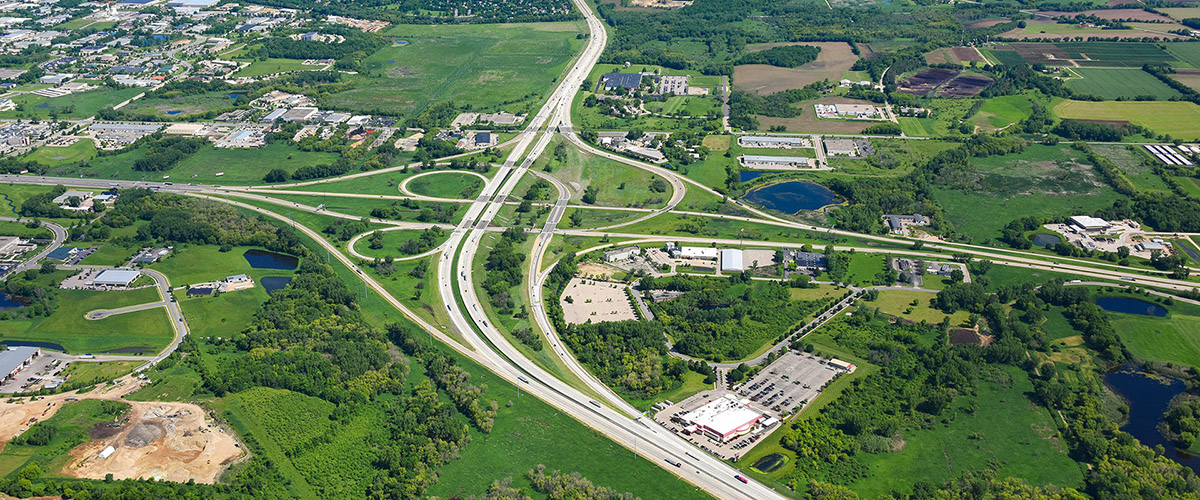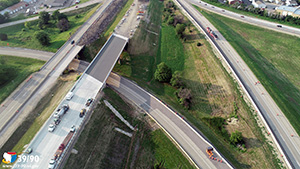New I-39/90 System Interchange Improves Safety and Future Traffic Levels

Written by: Lisa Dreifuerst, PE, Dane Partners
![]()
What do you find yourself thinking about on your morning commute? Need to respond to that email? Did you remember your laptop? Did you finalize that presentation? You’re probably not thinking about safety and traffic – unless someone cuts you off or your commute is taking longer than normal.
If you’re commuting in Dane County, you’re probably familiar with the Madison Beltline Interchange and know that it includes some of the most high-traffic areas in the state.
Dane Partners, LLC, worked with the Wisconsin Department of Transportation’s (WisDOT’s) Southwest Region to successfully design and deliver a $49 million Mega Project that reconstructed and reconfigured the I-39/90 system interchange at US 12/18 in Dane County, a project that was critical to the Wisconsin transportation system. Dane Partners is a joint venture of Ayres, Oneida Engineering Solutions, Short Elliot Hendrickson, and EMCS.
Scale
It was a large project that affected not only the immediate surrounding areas but also the state supply chain and tourism industry. The project included extensive coordination with key stakeholders, including the Ho-Chunk Nation, Dane County, City of Madison, and Town of Cottage Grove. This also included a series of video conferences with WisDOT and the Federal Highway Administration to preview reports and findings, which helped to expedite the approval process.
The team developed a range of alternatives for the interchange to accommodate future I-39/90 traffic levels (over 100,000 vehicles per day by the year 2040), focusing on safety issues that affect interstate travel and ensuring compatibility with the 45-mile I-39/90 reconstruction project to the south.
 Safety and Traffic Levels Go Hand-in-Hand
Safety and Traffic Levels Go Hand-in-Hand
The focus on safety required an extensive review of the reported crash history and an identification of the critical safety issue locations along I-39/90 so interchange improvements could be developed to address the greatest needs. Crash modification factors were used to complete a predictive safety analysis, resulting in performance-based recommendations based on the strongest safety improvement.
Southbound Vs Northbound
The southbound side had only a few considerations. The two existing lanes remained in place with a third lane added to the inside along with a new 12-foot shoulder and concrete median barrier. A dedicated exit-only lane was also added to southbound I-39/90 near the exit ramp to westbound US 12/18.
The northbound traffic saw the most significant changes, and two major alternatives were considered:
- If two lanes continued through the core of the interchange, total traffic on the Interstate and the northbound on-ramp from the Beltline would make a minimum of approximately 36,000 lane changes per day.
- If three lanes traveled through the core of the interchange, total traffic on the Interstate and the northbound on-ramp from the Beltline would make a minimum of approximately 68,500 lane changes per day, approximately 90% more than the two lane option.
The design team brought unique innovations to the interchange.
At first glance, it might not seem like a good idea to drop a lane in the middle of an interchange, only to add another lane a few thousand feet later. The traffic and safety impacts of each alternative were considered and, after thorough analysis and evaluation of each option, WisDOT determined that the two-lane alternative was the safest and most efficient of the alternatives considered.
 The new interchange is substantially safer and will accommodate expected increases in traffic. Users in southwest Wisconsin’s busiest interchange will no doubt be thankful for a safer and quicker travel experience.
The new interchange is substantially safer and will accommodate expected increases in traffic. Users in southwest Wisconsin’s busiest interchange will no doubt be thankful for a safer and quicker travel experience.
Wow! Who knew so much data and analysis went into making your daily commute safer and more efficient?
Next time you find yourself thinking about responding to that email or finalizing your presentation, know that engineers are thinking about your commute so you don’t have to.
About the Guest Blogger
Lisa Dreifuerst, PE, is a member of the Dane Partners team responsible for the project. Dane Partners is a joint venture between ACEC Wisconsin member firms: Oneida Engineering Solutions, Ayres Associates, Short Elliott Hendrickson, and EMCS Inc.
